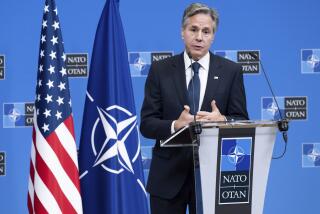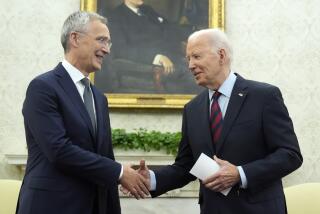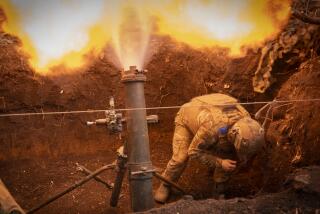Filling the Gaps in Europe
The United States has long encouraged its European allies to assume more responsibility for security in their region. An unprecedented step in that direction is now being taken. The 15-member European Union has agreed to form a rapid-reaction force of 60,000 troops, backed by hundreds of planes and scores of ships, that could be deployed in crises affecting Europe or nearby areas. Much remains to be worked out before this intention becomes a reality, including getting EU governments to boost defense spending for the upgrades the force requires to be effective.
The EU force is intended to take on those peacekeeping, humanitarian and even small-war missions that NATO--meaning, effectively, the United States--doesn’t want to take on. Its role would not involve territorial defense, though it plans on being able to project enough power to credibly deter aggression as well as protect itself. As NATO Secretary-General George Robertson put it, “NATO remains a cornerstone of European security and our only mechanism for collective defense. The Europeans are not seeking to rival that or to duplicate that, but they are saying that the Europeans should do more in their own backyard.” Many in the United States, especially in Congress, enthusiastically support that view.
The relationship between the EU force and NATO remains to be fully defined. The current plan says the EU force would have access to NATO assets, including facilities, planning staff and, in some cases, equipment. What most Europeans and the United States don’t want to see is duplicate planning bureaucracies, something U.S. Defense Secretary William S. Cohen rightly warns would be both expensive and divisive. Cohen’s sound idea is for a common planning process that could meet the separate needs of the EU force and NATO. France, as always resentful of the American role in Europe, argues that the Europeans be able to act “autonomously.” That sounds very much like a formula for confusion and rivalry that could only diminish the effectiveness of both forces.
The EU countries, with 2 million troops to draw from, should have no problem fleshing out the 60,000-member force. Germany, Britain and France have already pledged more than half the number of troops required, and smaller countries have promised the rest. But other significant shortfalls exist.
Only half of the 60 planes required for air defense suppression have been offered. The EU lacks the planes and ships to move its troops to where they are needed in the 60 days it has given itself to carry out a deployment. It needs more reconnaissance aircraft. Like the U.S. Army, the Europeans are still burdened with heavy Cold War-era equipment that, while suitable for confronting the Red Army in Central Europe, does not meet present-day requirements for lighter, speedily deployable forces.
Filling in the gaps won’t be cheap. That is where the real political challenge will come. The EU countries together spend on defense about 60% of what the United States does. There is little support in Europe for spending more. But the EU force can be operationally effective and politically credible only if it is equipped to go where it’s needed and do what its planners want it to do. The Europeans have agreed to field an important new security force. Next they have to agree on making sure it has the right tools for its mission.
More to Read
Sign up for Essential California
The most important California stories and recommendations in your inbox every morning.
You may occasionally receive promotional content from the Los Angeles Times.










